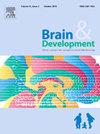低髓鞘性脑白质营养不良:从分子机制到临床进展
IF 1.3
4区 医学
Q4 CLINICAL NEUROLOGY
引用次数: 0
摘要
低髓鞘性白质营养不良症(hld)是一组以中枢神经系统髓鞘形成受损为特征的遗传性疾病。其中,Pelizaeus-Merzbacher病(PMD)是由PLP1基因突变引起的一种定义明确的x连锁白质营养不良,包括重复、错义变异体和零突变。最近的研究表明,不同类型的PLP1突变导致不同的病理机制:错义突变诱导内质网应激并激活未折叠蛋白反应(UPR), PLP1重复导致异常的细胞内运输和胆固醇积累,而不会激活UPR。此外,GJC2、SOX10、TUBB4A和POLR3A/B等其他基因的突变与各种形式的HLD有关,每种基因都具有独特的临床和影像学特征。神经影像学和下一代测序技术的进步使更准确、更早期的诊断成为可能,扩大了临床范围,加深了我们对疾病机制的理解。本文综述了目前关于hld的分子发病机制、基因型-表型相关性和诊断方法的知识,重点介绍了最近的生物学见解,这些见解可能为未来的治疗策略提供信息。本文章由计算机程序翻译,如有差异,请以英文原文为准。
Hypomyelinating leukodystrophy: From molecular mechanisms to clinical advances
Hypomyelinating leukodystrophies (HLDs) are a group of inherited disorders characterized by impaired myelin formation in the central nervous system. Among them, Pelizaeus-Merzbacher disease (PMD) is a well-defined X-linked leukodystrophy caused by mutations in the PLP1 gene, including duplications, missense variants, and null mutations. Recent studies have revealed that different types of PLP1 mutations lead to distinct pathomechanisms: while missense mutations induce endoplasmic reticulum stress and activate the unfolded protein response (UPR), PLP1 duplications cause aberrant intracellular trafficking and cholesterol accumulation without UPR activation. Additionally, mutations in other genes such as GJC2, SOX10, TUBB4A, and POLR3A/B have been implicated in various forms of HLD, each with unique clinical and imaging features. Advances in neuroimaging and next-generation sequencing have enabled more accurate and earlier diagnosis, expanding the clinical spectrum and deepening our understanding of disease mechanisms. This review summarizes the current knowledge on the molecular pathogenesis, genotype–phenotype correlations, and diagnostic approaches in HLDs, with an emphasis on recent biological insights that may inform future therapeutic strategies.
求助全文
通过发布文献求助,成功后即可免费获取论文全文。
去求助
来源期刊

Brain & Development
医学-临床神经学
CiteScore
3.60
自引率
0.00%
发文量
153
审稿时长
50 days
期刊介绍:
Brain and Development (ISSN 0387-7604) is the Official Journal of the Japanese Society of Child Neurology, and is aimed to promote clinical child neurology and developmental neuroscience.
The journal is devoted to publishing Review Articles, Full Length Original Papers, Case Reports and Letters to the Editor in the field of Child Neurology and related sciences. Proceedings of meetings, and professional announcements will be published at the Editor''s discretion. Letters concerning articles published in Brain and Development and other relevant issues are also welcome.
 求助内容:
求助内容: 应助结果提醒方式:
应助结果提醒方式:


